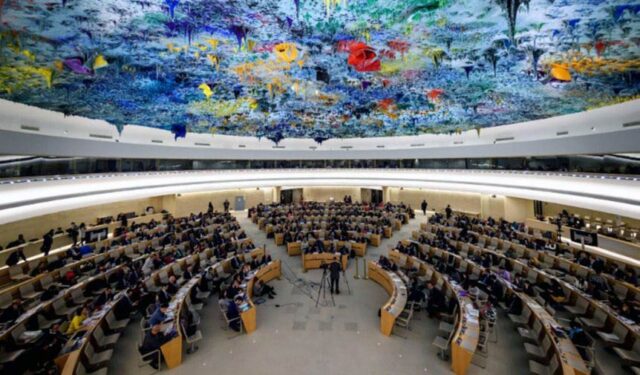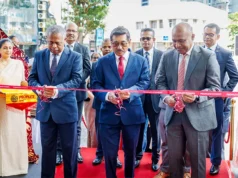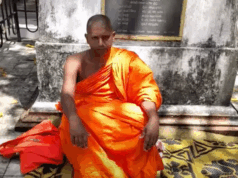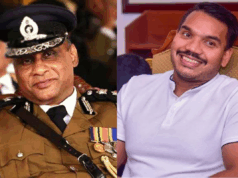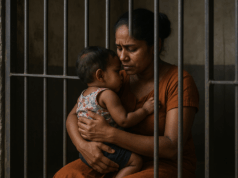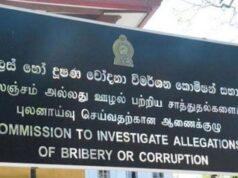by Tamara Kunanayakam
On 8 October this year, the Cabinet media spokesman Vijitha Herath announced the new JVP/NPP Government’s decision to “strongly reject” the US-UK draft resolution tabled by the United Kingdom at the recent session of the UN Human Rights Council, extending the mandate of an “external evidence-gathering mechanism” established by its 2022 resolution 51/1.
On the following day, Sri Lanka’s Permanent Representative to the UN explained to the Council that Sri Lanka considered the latest draft as lacking consensus, because the country had already opposed the two previous resolutions of 2021 (46/1) and 2022 (51/1) that had been tabled without the country’s consent and adopted by “a divided vote“. The Government she added, had also disassociated itself from the Report of the High Commissioner.
Nevertheless, on that same day, the resolution that the Government had “strongly” rejected was adopted without a vote, i.e., by consensus, and consensus resolutions necessarily involve the explicit or implicit consent of the country concerned.
Decision not to call for a vote – consent to, not rejection of, external mechanism with prosecutorial functions
Had indeed the Government “rejected” the external mechanism, it would have called for a recorded vote, the only way to prevent consensus on a hostile draft. Being a non-member state, it would have had to request a friendly country to act on its behalf, and Cuba, China and Pakistan have always obliged. Without a specific request from Sri Lanka, no country that respects the principle of state sovereignty and the right of peoples to self-determination would have called for a vote. It is evident that that request never came.
By the decision not to call for a vote, the Government did the opposite of what it had said it would do, even reversing Sri Lanka’s previous rejection of the mechanism at the Council’s 2021 and 2022, and consenting to its establishment as well as extension.
Country-specific resolutions are a weapon used by Washington to impose its hegemonic agenda on non-Western countries, and consensus is only advantageous to the one who wields the weapon. The resolution on Sri Lanka is precedent setting that gives legitimacy to the controversial ‘Responsibility to Protect’ doctrine that permits Washington to exercise its domination over other states on the pretext they are “unwilling and unable” to protect their own citizens, thus undermining the UN Charter-based multilateral order and its sovereignty principle.
Consensus, the result of behind-the-scenes ‘negotiations,’ deals, and capitulation
Consensus is always the result of behind-the-scenes ‘negotiations’, of deals made in private between the hostile country initiating the resolution and the target country, and of capitulation to outright threats or pressure. In the case of Sri Lanka, the initiator has always been the United States. The drafting is done in Washington and the text imposed in Colombo, with the US Ambassador playing a crucial role. The regular one-to-one meetings between the US Ambassador Julie Chung and Prime Minister Harini Amarasuriya, and between the Ambassador and the President is now an open secret.
Bilateral ‘negotiations’ and ‘agreements’ inherently unequal
Bilateral ‘negotiations’ or ‘agreements’ between a global hegemon and a small, heavily indebted Third World country are inherently unequal. The sheer hegemonic power of one makes the principle of reciprocity impracticable. It is illusory to believe that a US-led text, whether a resolution, a trade or military agreement, or for that matter IMF/World Bank conditionalities, can be “re-negotiated” or “amended” for “mutual benefit.” ‘Consensus’ between unequals can only signify capitulation, the abandon of sovereignty.
What did Sri Lanka surrender, its sovereignty? Back to the Kerry–Lugar Report
The answer may be found in Washington’s hegemonic ambitions, and the role attributed to Sri Lanka.
It is no secret that Sri Lanka is on a strategic maritime corridor linking East and West, the control over which is of central importance to Washington’s so-called ‘Free and Open Indo-Pacific’ military strategy aimed at containing and combating China. The wide-ranging reform of the State and its institutions demanded in US-led Human Rights Council resolutions and imposed through IMF/World Bank conditionalities can be traced to the December 2009 US Senate Foreign Relations Report, “Sri Lanka: Recharting US Strategy after the war” (Kerry-Lugar Report), prepared less than six months after the historic defeat of the LTTE.
Underlining that the US “cannot afford to ‘lose’ Sri Lanka,” the Report advocated “a new approach that increases US leverage”: “A more multifaceted US strategy would capitalize on the economic, trade, and security aspects of the relationship. This approach in turn could catalyze much-needed political reforms that will ultimately help secure longer term US strategic interests in the Indian Ocean. US strategy should also invest in Sinhalese parts of the country, instead of just focusing aid on the Tamil-dominated North and East. “
Washington’s ‘Free and Open Indo-Pacific’ strategy is the common denominator that links the US-led resolution with its embedded ‘Responsibility to Protect’ (R2P) logic and the IMF/World Bank duo’s political project to disempower the people and their state, which is camouflaged as ‘good governance’.
R2P, ‘good governance’, the false narrative – dismantling the sovereignty principle
R2P and ‘good governance’ are both aimed at dismantling the sovereignty principle – popular sovereignty and State sovereignty, the principal enemy and foremost obstacle to the expansion of global capital and US hegemonic ambitions. They both demand far-reaching reform of the state and its institutions that shift political decision-making and control over a nation’s wealth and resources into the hands of global corporates, beyond the control of the people and their democratic institutions. They are both associated with nebulous concepts such as ‘the rule of law,’ ‘transitional justice,’ ‘universal jurisdiction,’ ‘transparency,’ and ‘accountability’ – all of which serve to bring a country under alien domination. They both involve the reinforcement of the State’s repressive apparatus to preserve the new order of brutal exploitation thus established.
The term ‘good governance’, it must be recalled, was coined jointly by the US Treasury and the IMF/World Bank duo in the late 1980s as a coercive tool to bring former socialist bloc countries under the US hegemonic umbrella and to effectively recolonise indebted Third World countries. Presented as a technical tool involving wide-ranging legal and institutional reform to render government accountable and transparent, it is, in reality, a political project to re-engineer State to make it less, not more democratic.
Today, the false ‘good governance’ narrative has become so integrated into our daily lives that it has been adopted, without questioning, by the vast majority of political parties and trade unions, and even by the victims themselves, despite the visible and widespread suffering it causes. The rise to power of the JVP/NPP combine with as its figurehead the Harini Amarasuriya/AKD duo is a reflection of unprecedented degeneration of democracy, of popular sovereignty, in Sri Lanka.
BRICS, or not BRICS? Unanswered questions, Operation Camouflage
A question that comes to mind is why the JVP/NPP government treated the BRICS Summit in Kazan, Russia, with disdain? BRICS is viewed by Washington as a threat to its global hegemony. Why was Sri Lanka not represented by the President, nor the Prime Minister, nor even the Foreign Minister, when 36 of the 38 participating states were represented by their Heads of State or Government or by Cabinet Ministers? The United Nations was represented by its Secretary General. Along with Bangladesh, Sri Lanka was the only other country to send a Foreign Secretary. Bangladesh had, however, recently seen the installation of a pro-US banker as interim head of government after what is believed to have been a US-engineered coup d’état. But what about Sri Lanka? Is the answer to be found in the hand behind the Galle Face protest, misleadingly called ‘Aragalaya,’ and its aftermath?
And, why did the JVP/NPP government publicly lie that BRICS had rejected its application to become a member?
What was the purpose of the misleading public statement about rejecting the resolution?
To trick the public into believing that the new JVP/NPP combine reflects a radical ‘system change’ when in reality it provides a cover and relative stability for global corporates and for Washington’s project of disempowerment and vassalisation?
Is this a case of ‘operation camouflage’?

